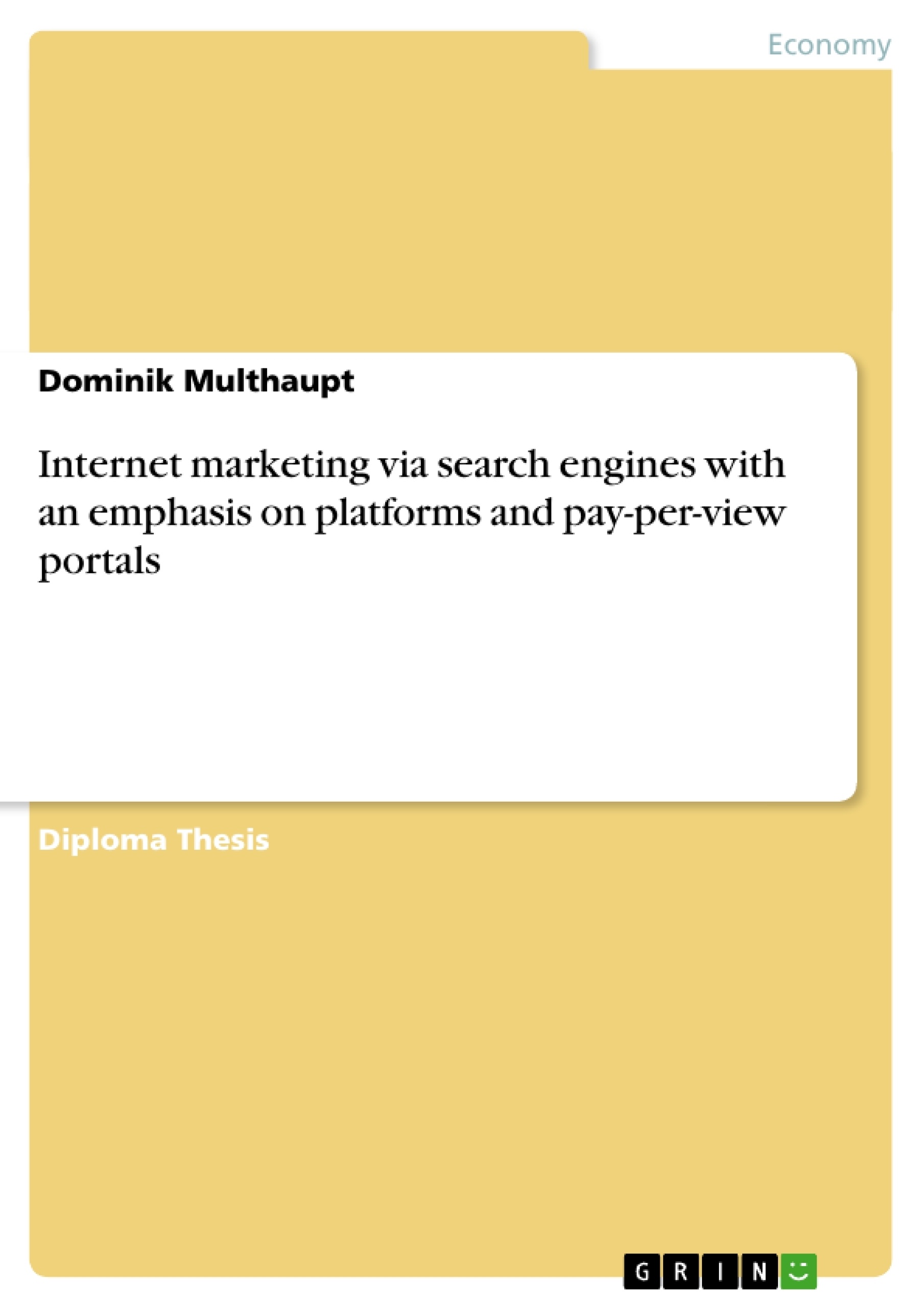For almost ten years, the Internet, a global data network, has been an open medium for public use,
leading to a closer relationship between producers and customers. This relationship is the result of the two main characteristics of the Internet: on the one hand it offers new ways of communicating, while also developing new
channels of distribution. As more or less all companies and a large number of private households have access to
the Internet , the field of marketing has expanded – and the so called “Internet Marketing” is more important than
ever before.
Even everyday radio- and TV-spots mention links in the Internet inviting the customer to visit their owner’s website. These websites are used either to present the companies themselves or to present the companies’ products and to
sell or distribute them online. The success of a company’s online offers depends on different factors: attraction of
the offerings, optimized pricing, appropriate measures to reach the target group, focus on target group and
promotion.
Here the question comes up: which measures can be taken to ensure potential customers are attracted to a
particular website? One of the main activities of users is the so-called “browsing” – the search for information
in the World Wide Web. The specific search for this information can be done through the use of search engines
such as Google, Yahoo or Fireball. This thesis will explain and work out how to use different types of
search engines, platforms and pay-per-view-portals to optimize a company’s marketing (exposure to target
audience).
Inhaltsverzeichnis (Table of Contents)
- On-topic
- Objective and Scope
- Method
- The Main Characteristics of Internet Marketing
- From Push- to Pull-Marketing
- Customer Empowerment, Global Range and Multimedia
- The Basic Steps of Internet Marketing
- Efficient Internet Marketing via Search Engines
- Important Technical Background
- Algorithms of Search Engines
- Clicks and Statistics
- The Network Behind
- Search Engine Optimisation
- Domain Names
- The Keyword Analysis
- Content and Design
- Linking Strategies
- Manipulation of Search Engines
- Internet Marketing on Platforms and Pay-per-View Portals
- Banner Advertisement
- Paid Placements and Paid Inclusions
- Edited Registers
- Platforms: Boards and Portals
- The Usefulness of Portals for Marketing Strategies
- Virtual Communities
- Affiliate Marketing and Viral Marketing via Platforms
- The Problem of Budgeting
- The Most Important Pay-per-View Portals
- Google AdWords
- What is AdWords?
- Organizing AdWords
- Strategies of Optimisation
- The Return on Investment
- Overture
- How Overture's Tools Work
- Overture's Guidelines of Relevance
- Optimisation of Overture
- The Control of Success
- Ranking Check and Control of Appearance of Paid Listings
- Measurement of Conversion
- Quality of Promotion and Website
- Quality of Tracked Data
- Summary and Outlook
Zielsetzung und Themenschwerpunkte (Objectives and Key Themes)
This diploma thesis examines the effectiveness of Internet marketing via search engines, with a particular focus on platforms and pay-per-view portals. The thesis aims to provide a comprehensive overview of the subject, covering important technical aspects, optimization strategies, and the most relevant platforms and tools. It also explores the challenges of measuring success and controlling the effectiveness of these marketing campaigns.
- The evolution and characteristics of Internet marketing
- The role of search engines in Internet marketing strategies
- Effective strategies for optimizing search engine visibility
- The use of platforms and pay-per-view portals for online advertising
- Methods for measuring and controlling the success of Internet marketing campaigns
Zusammenfassung der Kapitel (Chapter Summaries)
The first chapter introduces the topic of Internet marketing via search engines, defining its scope and objectives. The second chapter discusses the main characteristics of Internet marketing, including its shift from push to pull marketing, the increasing empowerment of customers, its global reach, and its multimedia nature. The third chapter delves into the technical aspects of search engines, including their algorithms, click statistics, and the network behind them. It also explores various search engine optimization techniques, such as keyword analysis, content optimization, and linking strategies.
The fourth chapter examines the use of platforms and pay-per-view portals for online advertising. It covers various forms of advertising, including banner advertisements, paid placements, edited registers, and affiliate marketing. The chapter also discusses the importance of platforms like boards and portals for marketing strategies, highlighting the impact of virtual communities and viral marketing. The fifth chapter focuses on the most important pay-per-view portals, Google AdWords and Overture. It details their features, tools, and optimization strategies, analyzing their effectiveness and return on investment. The sixth chapter explores methods for controlling the success of Internet marketing campaigns, including ranking checks, conversion tracking, and quality assessment.
Schlüsselwörter (Keywords)
This diploma thesis explores the key concepts of Internet marketing, search engine optimization (SEO), pay-per-view portals, online advertising, platforms, viral marketing, and conversion tracking. It focuses on platforms like Google AdWords and Overture, while analyzing the effectiveness of various strategies, including keyword analysis, content optimization, and paid placements. The work also examines the importance of measuring and controlling the success of online advertising campaigns.
- Citation du texte
- Dominik Multhaupt (Auteur), 2005, Internet marketing via search engines with an emphasis on platforms and pay-per-view portals, Munich, GRIN Verlag, https://www.grin.com/document/44368



